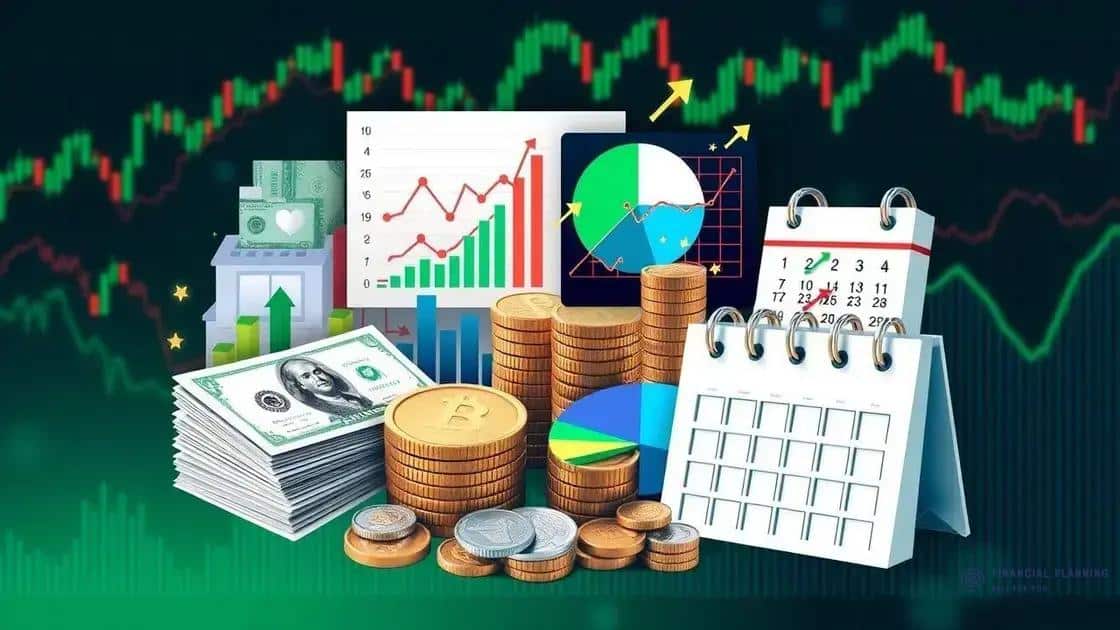Bond market instability amid major sell-offs

Bond market instability amid major sell-offs is primarily driven by rising interest rates, economic indicators, and changes in government policies, all of which can significantly impact bond prices and investor behavior.
Bond market instability amid major sell-offs has caught the attention of investors and analysts alike. You might be wondering how this affects your portfolio and what steps you can take to protect your investments.
Understanding the bond market’s recent sell-offs
Understanding the bond market’s recent sell-offs is crucial for investors looking to navigate today’s financial landscape. With rising interest rates and economic uncertainty, many are wondering what’s behind these fluctuations.
One of the key factors contributing to this instability is inflation. When inflation rises, the value of existing bonds decreases because new bonds are issued at higher interest rates. This creates a ripple effect, driving down bond prices across the board.
Factors Influencing Bond Sell-Offs
Several elements can impact the bond market and lead to significant sell-offs:
- Interest Rates: As central banks increase rates, existing bonds with lower rates become less attractive.
- Economic Data: Poor economic indicators can create fear, prompting investors to sell bonds.
- Market Sentiment: Investor psychology can cause sudden sell-offs based on perceived risk.
Alongside these factors, geopolitical events play a significant role. For instance, political instability or international trade tensions can create unpredictability, leading investors to reassess their positions in bonds. Consequently, you’re likely to see a surge in sell-offs during such events, as fear tends to drive the market.
Additionally, changes in government policy regarding fiscal stimulus can alter investors’ perceptions of bond safety. In times of stimulus, bond markets may react differently compared to periods of austerity. Understanding these nuances provides valuable insights into why sell-offs happen and helps investors make informed decisions.
By grasping these critical aspects, you can better position your portfolio to weather the ongoing changes in the bond market. Remember, maintaining a diversified investment strategy can provide more stability during such tumultuous times.
Key factors driving bond market instability

Key factors driving bond market instability can significantly affect investors’ strategies. Understanding these elements helps in adapting to a rapidly changing market.
One major factor is the interest rate environment. When central banks raise rates, it can lead to a sharp decline in bond prices. Higher rates make new bonds more appealing compared to existing ones, causing a sell-off of older bonds.
Economic Indicators
Several economic indicators can signal instability in the bond market:
- Inflation Rates: Rising inflation leads to decreased purchasing power and can prompt central banks to increase rates.
- Unemployment Rates: High unemployment can signify economic weakness, leading to reduced confidence in bond investments.
- GDP Growth: Slower growth may result in uncertainty, triggering volatility in the bond market.
Furthermore, geopolitical tensions can create unpredictability. Events such as wars, trade disputes, or changes in government policy can shift investor sentiment dramatically. This often leads to panic selling, which exacerbates market instability.
Market sentiment itself is another important factor. If investors collectively believe that the market is becoming unstable, their actions can become self-fulfilling. It can result in significant sell-offs, regardless of underlying economic fundamentals.
Lastly, changes in government fiscal policies can influence investor behavior. For instance, new tax policies or spending cuts can alter perceptions around market safety and return on investment.
Impact of rising interest rates on bonds
The impact of rising interest rates on bonds is significant and reshapes the entire investment landscape. As interest rates climb, the value of existing bonds typically declines, creating a challenging environment for bondholders.
When rates rise, new bonds are issued at higher yields, making them more attractive compared to older bonds with lower rates. This situation prompts investors to sell off their existing bonds, pushing prices down further. The relationship between interest rates and bond prices is key to understanding how the market reacts to economic changes.
Direct Consequences of Rising Rates
Several direct consequences arise when interest rates increase:
- Bond Price Decline: As new bonds offer better returns, older bonds lose value.
- Increased Yield: Investors can expect higher yields on new bonds, drawing them away from existing investments.
- Market Volatility: Sudden interest rate hikes can create panic among investors, leading to sudden sell-offs.
Moreover, rising rates affect various types of bonds differently. For instance, long-term bonds are typically more sensitive to interest rate changes than short-term bonds. When rates rise, long-term bonds can lose substantial value, exposing investors to even more risk.
The effect of rising interest rates extends beyond just the bond market. It can ripple through the economy, affecting borrowing costs and consumer spending. Higher interest rates often lead to increased mortgage rates and credit card interest, directly impacting households and businesses.
Therefore, understanding the implications of rising interest rates on bonds is crucial for making informed investment decisions. Keeping a close eye on central bank policies and economic indicators can provide valuable insights into future bond performance.
Investment strategies during market volatility

Investment strategies during market volatility are essential for navigating the uncertain waters of the financial landscape. When market conditions change rapidly, having a plan can help investors protect their assets and even find opportunities.
One effective strategy is diversification. By spreading investments across different asset classes, such as stocks, bonds, and real estate, investors can reduce risk. When one sector declines, others may perform well, cushioning the overall impact on the portfolio.
Utilizing Dollar-Cost Averaging
Another approach is dollar-cost averaging. This method involves investing a fixed amount of money at regular intervals, regardless of market conditions. By doing so, investors can buy more shares when prices are low and fewer shares when prices are high. This strategy helps mitigate the effects of volatility.
- Consistent Investing: Regular contributions help build wealth over time.
- Reduced Emotional Decision-making: Investing consistently limits emotional reactions to market changes.
- Average Cost Basis: Investors can lower their average purchase price.
Moreover, having a defined investment horizon is crucial. Short-term volatility often does not reflect the long-term potential of investments. By focusing on long-term goals, investors can avoid panic selling during downturns.
Additionally, maintaining a portion of the portfolio in cash can provide flexibility. Having cash reserves allows investors to take advantage of opportunities that may arise during a market dip. This strategy also helps to manage risk, as it provides a buffer against unexpected losses.
Lastly, regularly reviewing and adjusting investment strategies becomes vital. Staying informed about market trends and economic indicators can help investors make proactive adjustments to their portfolios. In uncertain times, being adaptable can enhance resilience against market fluctuations.
Future outlook for the bond market
The future outlook for the bond market is a topic of great interest for many investors. Various factors can shape trends and performance in this financial arena.
One key aspect to consider is interest rate policies. Central banks play a significant role in influencing bond prices. If rates continue to rise, existing bonds may face pressure, impacting their attractiveness to investors.
Predictions and Trends
Analysts often look at several indicators to forecast the bond market:
- Economic Growth: A strong economy often leads to higher interest rates, which can decrease bond prices.
- Inflation Levels: Rising inflation usually prompts central banks to raise rates, affecting bond yields.
- Investor Sentiment: If investors feel uncertain, they may shift towards safer assets, impacting the demand for bonds.
In addition, the emergence of new financial technologies can influence bond trading. For instance, online platforms make it easier for investors to trade bonds, which could increase market liquidity. With more participants in the market, volatility may also rise.
Furthermore, environmental, social, and governance (ESG) concerns are gaining traction. Investors are increasingly interested in bonds that align with their values. This shift may reshape the types of bonds that gain popularity in the coming years.
Understanding these factors provides valuable context for predicting how the bond market might evolve. Although uncertainty remains, staying informed about market trends can help investors make better decisions.
In conclusion, understanding the bond market is crucial for investors in today’s volatile environment. By grasping key factors like interest rates, market sentiment, and economic indicators, you can make informed investment decisions.
Diversification and employing effective strategies such as dollar-cost averaging can help manage risks. Keeping an eye on future trends like ESG investments will further enhance your investment approach. Always stay informed and adaptable as the market evolves.
FAQ – Frequently Asked Questions about the Bond Market
What happens to bonds when interest rates rise?
When interest rates rise, the prices of existing bonds typically fall. This is because new bonds are issued at higher rates, making the old ones less attractive.
How can I diversify my bond investments?
Diversifying bond investments involves spreading your allocation across different types of bonds, such as government, municipal, and corporate bonds, to reduce risk.
What is dollar-cost averaging in bond investing?
Dollar-cost averaging means investing a fixed amount in bonds regularly, regardless of price. This strategy helps manage risk and lowers the average cost over time.
How can ESG trends impact the bond market?
ESG trends can lead to increased demand for bonds that meet environmental and social criteria. Investors are more likely to support issuers committed to sustainability practices.





